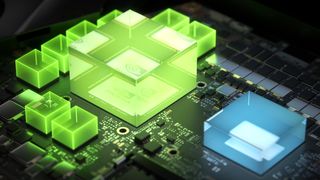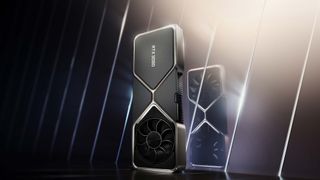Cheat Sheet: Nvidia 30-series
Everything you need to know about Nvidia’s 30-series GPUs

Nvidia graphics cards still dominate the laptop GPU landscape, although AMD Radeon 6000, and soon Intel Arc, are doing their best to change that. Whether you’re looking for a gaming laptop capable of the latest ray tracing capabilities or something more mid-tier, Nvidia offers a range of options in today’s best gaming laptops. But which of Nvidia’s many chips is right for you? Are you a mobile professional that does a little gaming on the side or a hardcore gamer who’s looking to squeeze every bit of power out of their system? Or are you somewhere in between? No matter how you identify, our handy explainer will help you choose the best Nvidia 30-series GPU for you.
High-end gaming, ray tracing: Nvidia GeForce RTX 30-Series
Currently at the top of the heap among Nvidia graphics cards is the RTX 30-series. Based on the latest Ampere architecture, the 30-series pushes forward the impressive ray tracing technology introduced in the previous generation 20-series cards. Let’s take a look at the keys stats spanning seven SKUs. The top row is the GPU’s name, higher numbers in the name indicate a more powerful card. Card names ending in “Ti” are superior to the non-Ti version of the same model number.
| Row 0 - Cell 0 | RTX 3080 Ti Laptop GPU | RTX 3080 Laptop GPU | RTX 3070 Ti Laptop GPU | RTX 3070 Laptop GPU | RTX 3060 Laptop GPU | RTX 3050 Ti Laptop GPU | RTX 3050 Laptop GPU |
| NVIDIA CUDA Cores | 7424 | 6144 | 5888 | 5120 | 3840 | 2560 | 2048 |
| Boost Clock (MHz) | 1125 - 1590 MHz | 1245 - 1710 MHz | 1035 - 1485 MHz | 1290 - 1620 MHz | 1283 - 1703 MHz | 1035 - 1695 MHz | 1057 - 1740 MHz |
| GPU Subsystem Power (W) | 80 - 150 W | 80 - 150 W | 80 - 125 W | 80 - 125 W | 60 - 115 W | 35 - 80 W | 35 - 80 W |
| Standard Memory Config | 16 GB GDDR6 | 8 GB GDDR6/16 GB GDDR6 | 8 GB GDDR6 | 8 GB GDDR6 | 6 GB GDDR6 | 4 GB GDDR6 | 4 GB GDDR6 |
| Ray Tracing Cores | 2nd Generation | 2nd Generation | 2nd Generation | 2nd Generation | 2nd Generation | 2nd Generation | 2nd Generation |
| Tensor Cores | 3rd Generation | 3rd Generation | 3rd Generation | 3rd Generation | 3rd Generation | 3rd Generation | 3rd Generation |
Nvidia 30-Series chart breakdown: For nerds and the curious
Nvidia CUDA cores are highly specialized processing units in Nvidia GPUs used by many programming languages to more easily leverage the compute power of the GPU, which is already a very specialized component of any computer. These cores are tasked with doing lots of floating point math, a very compute-intensive process used in 3D rendering. A higher CUDA core count generally indicates a more capable GPU.
A GPU’s Boost Clock, measured in megahertz, is the performance speed of the GPU at its peak when under the heaviest workloads it can manage. A GPU can “boost” itself to a faster clock speed for a period of time while remaining within thermal and power thresholds for short-term intensive tasks. This is essentially the highest speed at which the processor clock that governs all tasks can output a signal or instruction. The RTX 3080 at its listed boosted performance can output up to 1.59 million instructions a second. You’ll notice lower number cards can have higher listed clock speeds, but with fewer compute cores and less available memory, the card still won’t outperform its bigger siblings.

The listed GPU “subsystem” power, measured in Watts, is the rated power draw range of the card which can fluctuate as demands on the system rise and fall. This can play a large role in laptop battery life.
The memory configuration indicates the available Video RAM, measured in Gigabytes, used to store information needed in the short-term. While your laptop has its own RAM, modern GPUs require dedicated VRAM, often of similar amounts, to do their job. Larger VRAM pools allow a GPU to store graphical instruction data in a place where access speeds are many times faster than reading from your hard drive or SSD. A lower amount of VRAM means more (relatively) slow trips to the SSD to pull down that data. More VRAM is always better. All 30-series cards come with the latest memory standard known as GDDR6 (Graphical Double Data Rate, for you acronym nerds) which has rated transfer speeds of 16Gb/s.
The Ray Tracing Cores and Tensor Cores are indicated here as the current generation of those processing units. Ray Tracing Cores help with the very intensive work of rendering ray traced effects on surfaces in games. Tensor cores are another specialized part of the GPU responsible for doing the relational math between vertices and matrices needed for modern 3D graphical effects and are a key component of AI systems like DLSS.
Stay in the know with Laptop Mag
Get our in-depth reviews, helpful tips, great deals, and the biggest news stories delivered to your inbox.
Nvidia 30-Series summary: For everyone else
Don’t worry if not all of that landed, the major take away from this is that Nvidia has seven very powerful GPUs on the market and while each higher model number generally outperforms the one below it, there are some quirks in the 30-series when it comes to processor speed. This means you might not need to drop the money on a top-of-the-line RTX 3080 Ti and should check performance reviews of specific configurations before deciding bigger is better.

The RTX 3080 and RTX 3080 Ti are your high-end options that shouldn’t run any modern game below 60 frames per second. Examples include the MSI GE76 Raider for a hefty $4,199, equipped with a 3080 Ti and a shiny new 12th Gen Alder Lake Intel CPU if you feel like blowing the doors off of everything. In our tests it ran Red Dead Redemption 2 at 82 fps. Then at half the price there’s the Acer Nitro 5, pairing an AMD Ryzen 6 5900HX CPU with an RTX 3080 for $2,300 that also performs very well running Assassin's Creed Odyssey at 64 FPS at 1080p resolution on Highest settings.
Down the ladder, but still very capable are the RTX 3070 and RTX 3070 Ti cards.You should expect a solid price cut without much of a performance dip out of 3070s. The Alienware m15 R4 ran Assassin’s Creed Odyssey at 67 fps (see?) at 1080p, but you pay that Alienware premium in this case at $2,499. Same game, Gigabyte Aorus 15G, same settings: 64 fps. Not too bad for $1,799, but with some quality of life caveats as indicated in the review.

Next up, and formerly the lowest performing of the 30-series cards is the RTX 3060. Laptops with these won’t break fps category records, but they shouldn’t break the bank either. If you don’t demand more than a comfortable 60 FPS to run your latest games at-or-near high settings, a 3060 should do you just fine. On our deals page, RTX 3060 equipped laptops can be found from $1,199 up to $1,899.
Lastly in the 30-series line are the newly added, entry level RTX 3050 and RTX 3050 Ti cards. These guys should get you over the line at 60 FPS, unless you’re running a particularly taxing game at especially high settings. With fewer compute cores than the big boys, the 3050s still have fast enough clock speeds to mean business. The best part about them, of course, is the price. RTX 3050 equipped laptops can range as low as $650 if you catch the right sale (this one’s sold out, sorry for the tease!). But they don’t get much higher, easily under $1,000 for most configurations. At four times cheaper, they’re certainly not four times less powerful than their 3080 counterparts, so weigh your options accordingly.
New mid-tier options coming soon
Coming to laptops in early 2022 from Nvidia are a selection of three mid-tier graphics card options for lightweight configurations capable of some high-end graphical settings like Ray Tracing, while keeping power draw, weight and heat concerns low.

Information on which brands will come equipped with the new GeForce discrete GPUs hasn’t yet been announced, and even some of the specs for the cards aren’t fully known yet, but here’s what we do know about these cards.
Nvidia GeForce RTX 2050: A 30-series card in all but name
The confusingly designated RTX 2050 isn’t based on the previous 20-series Turing architecture as might be surmised by the name. RTX 2050 cards actually run on the Ampere architecture, just like the 30-series cards, which makes the RTX 2050 for laptops more comparable to an RTX 3050 than an RTX 2060. At 2048 CUDA cores and 4GB of GDDR6 VRAM, it matches the RTX 3050 while having a smaller memory width at 64 bits compared to 128. Comparisons to the RTX 2060 are less evenly matched, a 2060 has fewer CUDA cores at 1920 but higher memory capacity at 6 GB and a higher boost clock.
The goal of the RTX 2050 appears to be providing a lower power consumption graphics configuration on the latest Ray Tracing platform.
Nvidia GeForce MX570 and MX550: For lightweight performance
Not a lot has been revealed yet on the new MX GeForce laptop cards including no announced laptops that will come equipped with either card. The official announcement says to expect their arrival in Spring 2022 and in the meantime we have some preliminary statements and some speculation to tide us over.
The MX line represents a low-spec but still meaningful upgrade in performance over integrated graphics, so the chief comparison that MX-equipped laptops have is against laptops with no dedicated GPUs at all. Although the performance of integrated graphics is in a much better place today than it was not long ago, any next-gen gaming still requires a dedicated GPU as do most rendering software applications.
The new MX570 will feature “more power-efficient CUDA Cores and with faster memory speeds than previous MX GPUs” according to the Nvidia announcement. The information on the lower-spec MX 550 isn’t any more detailed, stating simply that it will have “more CUDA Cores and faster memory speeds than before”. The most recently released MX GPU, the MX450 was released in August 2020, and is of Turing design with 2 GB of GDDR6 memory on a 64 bit memory bus with a base clock of 1.3 GHz and a boost clock of 1.5 GHz. So expect a generational uplift from those modest numbers.
